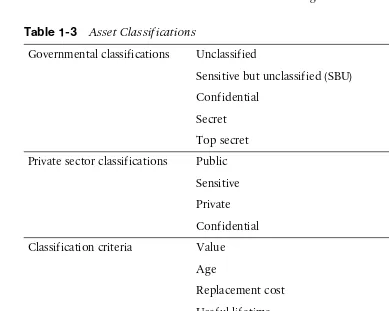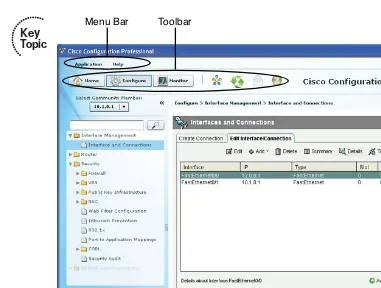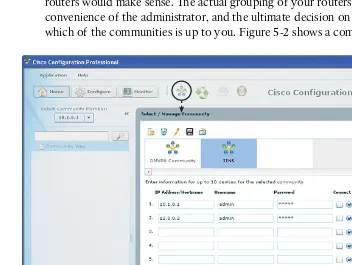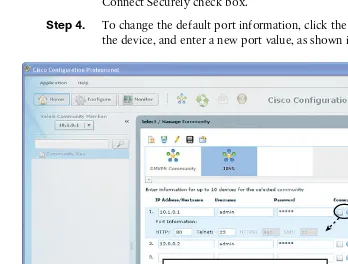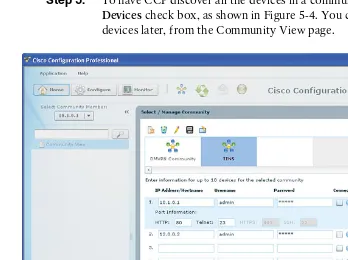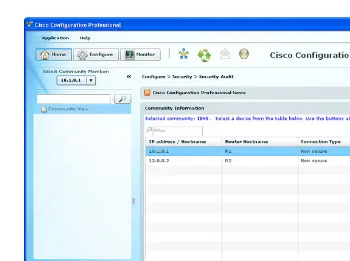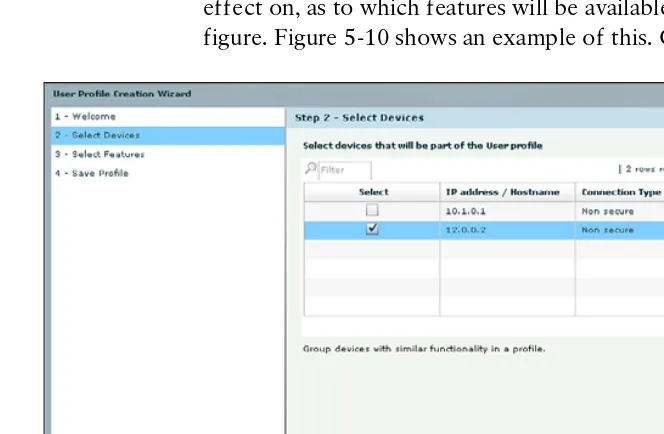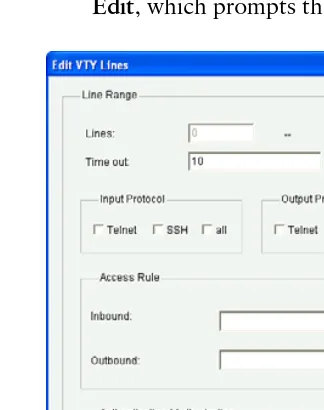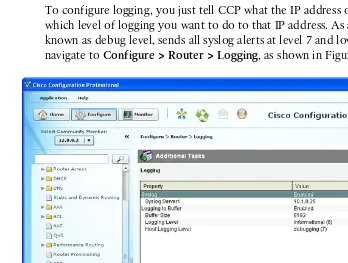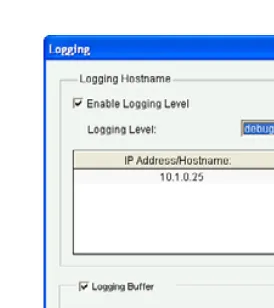ptg8286219
Cisco Press
800 East 96th StreetIndianapolis, IN 46240
CCNA Security 640-554
Official Cert Guide
Keith Barker, CCIE No. 6783
ptg8286219
ii CCNA Security 640-554 Official Cert Guide
CCNA Security 640-554 Official Cert Guide
Keith Barker, CCIE No. 6783Scott Morris, CCIE No. 4713
Copyright© 2013 Pearson Education, Inc. Published by:
Cisco Press 800 East 96th Street Indianapolis, IN 46240
All rights reserved. No part of this book may be reproduced or transmitted in any form or by any means, electronic or mechanical, including photocopying, recording, or by any information storage and retrieval system, without written permission from the publisher, except for the inclusion of brief quotations in a review.
Printed in the United States of America 1 2 3 4 5 6 7 8 9 0 First Printing July 2012
Library of Congress Cataloging-in-Publication data is on file. ISBN13: 978-1-58720-446-3
ISBN: 1-58720-446-0
Warning and Disclaimer
This book is designed to provide information about selected topics for the CCNA Security 640-554 exam. Every effort has been made to make this book as complete and as accurate as possible, but no warranty or fitness is implied.
The information is provided on an “as is” basis. The authors, Cisco Press, and Cisco Systems, Inc. shall have neither liability nor responsibility to any person or entity with respect to any loss or damages arising from the information contained in this book or from the use of the discs or programs that may accompany it.
ptg8286219
iii
Feedback Information
At Cisco Press, our goal is to create in-depth technical books of the highest quality and value. Each book is crafted with care and precision, undergoing rigorous development that involves the unique expertise of members from the professional technical community.
Readers’ feedback is a natural continuation of this process. If you have any comments about how we could improve the quality of this book, or otherwise alter it to better suit your needs, you can contact us through email at feedback@ciscopress.com . Please make sure to include the book title and ISBN in your message. We greatly appreciate your assistance.
Corporate and Government Sales
Cisco Press offers excellent discounts on this book when ordered in quantity for bulk purchases or spe-cial sales. For more information, please contact: U.S. Corporate and Government Sales 1-800-382-3419 corpsales@pearsontechgroup.com
For sales outside of the U.S., please contact: International Sales international@pearsoned.com
Trademark Acknowledgments
All terms mentioned in this book that are known to be trademarks or service marks have been appropri-ately capitalized. Cisco Press or Cisco Systems, Inc. cannot attest to the accuracy of this information. Use of a term in this book should not be regarded as affecting the validity of any trademark or service mark.
Publisher: Paul Boger Manager, Global Certification: Erik Ullanderson
Associate Publisher : Dave Dusthimer Business Operation Manager, Cisco Press: Anand Sundaram
Executive Editor: Brett Bartow Technical Editors: Brandon Anastasoff and David Burns
Managing Editor: Sandra Schroeder Development Editor: Andrew Cupp
Senior Project Editor: Tonya Simpson Editorial Assistant: Vanessa Evans
Indexer: Heather McNeill Copy Editor: Keith Cline
ptg8286219
iv CCNA Security 640-554 Official Cert Guide
About the Authors
Keith Barker , CCIE No. 6783 (R&S and Security), is a 27-year veteran of the networking industry. He currently works as a network engineer and trainer for Copper River IT. His past experience includes EDS, Blue Cross, Paramount Pictures, and KnowledgeNet, and he has delivered CCIE-level training over the past several years. As part of the original set of Cisco VIPs for the Cisco Learning Network, he continues to give back to the com-munity in many ways. He is CISSP and CCSI certified, loves to teach, and keeps many of his video tutorials at http://www.youtube.com/keith6783 . He can be reached at Keith. Barker@CopperRiverIT.com or by visiting http://www.CopperRiverIT.com .
Scott Morris , CCIE No. 4713 (R&S, ISP/Dial, Security, and Service Provider), has more than 25 years in the industry. He also has CCDE and myriad other certifications, includ-ing nine expert-level certifications spread over four major vendors. Havinclud-ing traveled the world consulting for various enterprise and service provider companies, Scott currently works at Copper River IT as the chief technologist. He, too, has delivered CCIE-level training and technology training for Cisco Systems and other technology vendors. Having spent a “past life” (early career) as a photojournalist, he brings interesting points of view from entering the IT industry from the ground up. As part of the original set of Cisco VIPs for the Cisco Learning Network, he continues to give back to the community in many ways. He can be reached at smorris@CopperRiverIT.com or by visiting http:// www.CopperRiverIT.com .
About the Contributing Authors
Kevin Wallace , CCIE No. 7945, is a certified Cisco instructor holding multiple Cisco certifications, including CCSP, CCVP, CCNP, and CCDP. With Cisco experience dating back to 1989, Kevin has been a network design specialist for the Walt Disney World Resort, a senior technical instructor for SkillSoft/Thomson NETg/KnowledgeNet, and a network manager for Eastern Kentucky University. Kevin holds a bachelor of science degree in electrical engineering from the University of Kentucky. Kevin has also authored or co-authored multiple books for Cisco Press, including: CCNP TSHOOT
642-832 Cert Kit , CCNP TSHOOT 642-832 Official Certification Guide , CCNP
ROUTE 642-902 Cert Kit , and CCNP Routing and Switching Official Certification
Library , all of which target the current CCNP certification.
ptg8286219
v
About the Technical Editors
Brandon Anastasoff has been a systems engineer with Cisco Systems since October 2007, when he moved from a lead network architect role in a major newspaper-publish-ing firm. He has spent more than 20 years in the industry, focusnewspaper-publish-ing on security for the past 10 and obtaining certifications inside and outside of Cisco, with his CISSP, CCSP, and most recently, the Security CCIE. After studying in the United Kingdom, Brandon took a year off in Saudi Arabia to see what a real job would be like before proceed-ing to college, but found the lure of an income too irresistible and never went back for the degree. Brandon had to make a choice early in his career to either follow the art of computer animation or the up-and-coming PC networking boom, and he has never regretted the decision to enter networking. He moved from early versions of Windows and Macintosh operating systems through Novell’s NetWare, and then moved more into the infrastructure side, focusing mostly on Cisco LAN/WAN equipment. After Y2K, the focus became more security oriented, and Brandon became familiar with virus and Trojan analysis and forensic investigations. Today, Brandon is glad to be where he is and enjoys talking about security whenever the opportunity presents itself.
ptg8286219
vi CCNA Security 640-554 Official Cert Guide
Dedications
From Keith:
To my parents for bringing me into this world, to my children for perpetuating this world, and to my wonderful wife, Jennifer, for making my current world a better place. I love you, Jennifer.
From Scott:
The variety of inspirations and muses that affect a person’s life vary over time. Every one of them affects us in different ways to help shape or drive us to where we are today. I certainly enjoy all the influences that have helped to shape (or warp) me to where I cur-rently am. To my friend and co-author Keith, for convincing me that this was a good idea and a lot of fun to do (and gently “reminding” me of that along the way). To my dear friend Amy (who is smarter than I am) for continuing to tell me that I need to get my CCIE Voice taken care of and prodding me along now and then, motivating me to be something more than what I am currently. To my dear friend Angela, who enjoys keep-ing me both sane and humble by pokkeep-ing holes in my plans and helpkeep-ing me make thkeep-ings even better while keeping my sense of humor intact. And to my two little girls, who help keep my perspective on the world both healthy and a little off-kilter.
Acknowledgments
We want to thank many people for helping us put this book together.
The Cisco Press team: Brett Bartow, the executive editor, was the catalyst for this proj-ect, coordinating the team and ensuring that sufficient resources were available for the completion of the book. Andrew Cupp, the development editor, has been invaluable in producing a high-quality manuscript. His great suggestions and keen eye caught some technical errors and really improved the presentation of the book. We would also like to thank Tonya Simpson and the production team for their excellent work in shepherding this book through the editorial process and nipping at our heels where necessary. Many thanks go to Keith Cline for going the extra mile during the copy edit. The technical reviewers: We want to thank the technical reviewers of this book, Brandon Anastasoff and David Burns, for their thorough, detailed review and very valuable input. Our families: Of course, this book would not have been possible without the constant understanding and patience of our families. They have lived through the long days and nights it took to complete this project, and have always been there to poke, prod, moti-vate, and inspire us. We thank you all.
ptg8286219
Contents at a Glance vii
Contents at a Glance
Introduction xxv
Part I
Fundamentals of Network Security 3
Chapter 1 Networking Security Concepts 5
Chapter 2 Understanding Security Policies Using a Lifecycle Approach 23
Chapter 3 Building a Security Strategy 37
Part II
Protecting the Network Infrastructure 47
Chapter 4 Network Foundation Protection 49
Chapter 5 Using Cisco Configuration Professional to Protect the Network Infrastructure 63
Chapter 6 Securing the Management Plane on Cisco IOS Devices 91
Chapter 7 Implementing AAA Using IOS and the ACS Server 137
Chapter 8 Securing Layer 2 Technologies 175
Chapter 9 Securing the Data Plane in IPv6 199
Part III
Mitigating and Controlling Threats 219
Chapter 10 Planning a Threat Control Strategy 221
Chapter 11 Using Access Control Lists for Threat Mitigation 235
Chapter 12 Understanding Firewall Fundamentals 267
Chapter 13 Implementing Cisco IOS Zone-Based Firewalls 291
Chapter 14 Configuring Basic Firewall Policies on Cisco ASA 327
Chapter 15 Cisco IPS/IDS Fundamentals 371
Chapter 16 Implementing IOS-Based IPS 389
Part IV
Using VPNs for Secure Connectivity 421
Chapter 17 Fundamentals of VPN Technology 423
Chapter 18 Fundamentals of the Public Key Infrastructure 441
ptg8286219
viii CCNA Security 640-554 Official Cert Guide
Chapter 20 Implementing IPsec Site-to-Site VPNs 495
Chapter 21 Implementing SSL VPNs Using Cisco ASA 529
Chapter 22 Final Preparation 559
Part V
Appendixes 565
A Answers to the “Do I Know This Already?” Quizzes 567
B CCNA Security 640-554 (IINSv2) Exam Updates 573
Glossary 577
Index 587
CD-Only Appendixes
C Memory Tables 3
ptg8286219
Contents ix
Contents
Introduction xxv
Part I Fundamentals of Network Security 3
Chapter 1 Networking Security Concepts 5
“Do I Know This Already?” Quiz 5 Foundation Topics 8
Understanding Network and Information Security Basics 8
Network Security Objectives 8
Confidentiality, Integrity, and Availability 8 Cost-Benefit Analysis of Security 9
Classifying Assets 10 Classifying Vulnerabilities 11 Classifying Countermeasures 12 What Do We Do with the Risk? 12 Recognizing Current Network Threats 13
Potential Attackers 13 Attack Methods 14 Attack Vectors 15
Man-in-the-Middle Attacks 15
Other Miscellaneous Attack Methods 16
Applying Fundamental Security Principles to Network Design 17 Guidelines 17
How It All Fits Together 19 Exam Preparation Tasks 20 Review All the Key Topics 20
Complete the Tables and Lists from Memory 20 Define Key Terms 20
Chapter 2 Understanding Security Policies Using a Lifecycle Approach 23
“Do I Know This Already?” Quiz 23 Foundation Topics 25
ptg8286219
x CCNA Security 640-554 Official Cert Guide
Security Policies 28
Who, What, and Why 28 Specific Types of Policies 29
Standards, Procedures, and Guidelines 30 Testing the Security Architecture 31
Responding to an Incident on the Network 32 Collecting Evidence 32
Reasons for Not Being an Attacker 32 Liability 33
Disaster Recovery and Business Continuity Planning 33 Exam Preparation Tasks 34
Review All the Key Topics 34
Complete the Tables and Lists from Memory 34 Define Key Terms 34
Chapter 3 Building a Security Strategy 37
“Do I Know This Already?” Quiz 37 Foundation Topics 40
Securing Borderless Networks 40 The Changing Nature of Networks 40 Logical Boundaries 40
SecureX and Context-Aware Security 42 Controlling and Containing Data Loss 42
An Ounce of Prevention 42 Secure Connectivity Using VPNs 43 Secure Management 43
Exam Preparation Tasks 44 Review All the Key Topics 44
Complete the Tables and Lists from Memory 44 Define Key Terms 44
Part II Protecting the Network Infrastructure 47
Chapter 4 Network Foundation Protection 49
“Do I Know This Already?” Quiz 49 Foundation Topics 52
Using Network Foundation Protection to Secure Networks 52 The Importance of the Network Infrastructure 52
ptg8286219
Contents xi
Interdependence 53 Implementing NFP 53
Understanding the Management Plane 55 First Things First 55
Best Practices for Securing the Management Plane 55 Understanding the Control Plane 56
Best Practices for Securing the Control Plane 56 Understanding the Data Plane 57
Best Practices for Protecting the Data Plane 59 Additional Data Plane Protection Mechanisms 59 Exam Preparation Tasks 60
Review All the Key Topics 60
Complete the Tables and Lists from Memory 60 Define Key Terms 60
Chapter 5 Using Cisco Configuration Professional to Protect the Network Infrastructure 63
“Do I Know This Already?” Quiz 63 Foundation Topics 65
Introducing Cisco Configuration Professional 65 Understanding CCP Features and the GUI 65
The Menu Bar 66 The Toolbar 67
Left Navigation Pane 68 Content Pane 69 Status Bar 69
Setting Up New Devices 69 CCP Building Blocks 70
Communities 70 Templates 74 User Profiles 78 CCP Audit Features 81
One-Step Lockdown 84 A Few Highlights 84 Exam Preparation Tasks 88 Review All the Key Topics 88
Complete the Tables and Lists from Memory 88 Define Key Terms 88
ptg8286219
xii CCNA Security 640-554 Official Cert Guide
Chapter 6 Securing the Management Plane on Cisco IOS Devices 91
“Do I Know This Already?” Quiz 91 Foundation Topics 94
Securing Management Traffic 94
What Is Management Traffic and the Management Plane? 94 Beyond the Blue Rollover Cable 94
Management Plane Best Practices 95 Password Recommendations 97 Using AAA to Verify Users 97
AAA Components 98
Options for Storing Usernames, Passwords, and Access Rules 98 Authorizing VPN Users 99
Router Access Authentication 100 The AAA Method List 101
Role-Based Access Control 102
Custom Privilege Levels 103
Limiting the Administrator by Assigning a View 103
Encrypted Management Protocols 103 Using Logging Files 104
Understanding NTP 105 Protecting Cisco IOS Files 106
Implement Security Measures to Protect the Management Plane 106 Implementing Strong Passwords 106
User Authentication with AAA 108
Using the CLI to Troubleshoot AAA for Cisco Routers 113 RBAC Privilege Level/Parser View 118
Implementing Parser Views 120 SSH and HTTPS 122
Implementing Logging Features 125
Configuring Syslog Support 125
SNMP Features 128 Configuring NTP 131
Securing the Cisco IOS Image and Configuration Files 133 Exam Preparation Tasks 134
Review All the Key Topics 134
Complete the Tables and Lists from Memory 135 Define Key Terms 135
ptg8286219
Contents xiii Chapter 7 Implementing AAA Using IOS and the ACS Server 137
“Do I Know This Already?” Quiz 137 Foundation Topics 140
Cisco Secure ACS, RADIUS, and TACACS 140 Why Use Cisco ACS? 140
What Platform Does ACS Run On? 141 What Is ISE? 141
Protocols Used Between the ACS and the Router 141 Protocol Choices Between the ACS Server and the Client
(the Router) 142
Configuring Routers to Interoperate with an ACS Server 143 Configuring the ACS Server to Interoperate with a Router 154 Verifying and Troubleshooting Router-to-ACS Server Interactions 164 Exam Preparation Tasks 171
Review All the Key Topics 171
Complete the Tables and Lists from Memory 171 Define Key Terms 171
Command Reference to Check Your Memory 172
Chapter 8 Securing Layer 2 Technologies 175
“Do I Know This Already?” Quiz 175 Foundation Topics 178
VLAN and Trunking Fundamentals 178 What Is a VLAN? 178
Trunking with 802.1Q 180
Following the Frame, Step by Step 181 The Native VLAN on a Trunk 181
So, What Do You Want to Be? (Says the Port) 182 Inter-VLAN Routing 182
The Challenge of Using Physical Interfaces Only 182 Using Virtual “Sub” Interfaces 182
Spanning-Tree Fundamentals 183
Loops in Networks Are Usually Bad 184 The Life of a Loop 184
The Solution to the Layer 2 Loop 184 STP Is Wary of New Ports 187
ptg8286219
xiv CCNA Security 640-554 Official Cert Guide
Common Layer 2 Threats and How to Mitigate Them 188
Disrupt the Bottom of the Wall, and the Top Is Disrupted, Too 188 Layer 2 Best Practices 189
Do Not Allow Negotiations 190 Layer 2 Security Toolkit 190
Specific Layer 2 Mitigation for CCNA Security 191
BPDU Guard 191 Root Guard 192 Port Security 192
Exam Preparation Tasks 195 Review All the Key Topics 195
Complete the Tables and Lists from Memory 195
Review the Port Security Video Included with This Book 196 Define Key Terms 196
Command Reference to Check Your Memory 196
Chapter 9 Securing the Data Plane in IPv6 199
“Do I Know This Already?” Quiz 199 Foundation Topics 202
Understanding and Configuring IPv6 202 Why IPv6? 202
The Format of an IPv6 Address 203
Understanding the Shortcuts 205 Did We Get an Extra Address? 205 IPv6 Address Types 206
Configuring IPv6 Routing 208 Moving to IPv6 210
Developing a Security Plan for IPv6 210
Best Practices Common to Both IPv4 and IPv6 210 Threats Common to Both IPv4 and IPv6 212 The Focus on IPv6 Security 213
New Potential Risks with IPv6 213 IPv6 Best Practices 214
Exam Preparation Tasks 216 Review All the Key Topics 216
Complete the Tables and Lists from Memory 216 Define Key Terms 217
ptg8286219
Contents xv Part III Mitigating and Controlling Threats 219
Chapter 10 Planning a Threat Control Strategy 221
“Do I Know This Already?” Quiz 221 Foundation Topics 224
Designing Threat Mitigation and Containment 224 The Opportunity for the Attacker Is Real 224 Many Potential Risks 224
The Biggest Risk of All 224 Where Do We Go from Here? 225
Securing a Network via Hardware/Software/Services 226 Switches 227
Routers 228 ASA Firewall 230
Other Systems and Services 231 Exam Preparation Tasks 232 Review All the Key Topics 232
Complete the Tables and Lists from Memory 232 Define Key Terms 232
Chapter 11 Using Access Control Lists for Threat Mitigation 235
“Do I Know This Already?” Quiz 235 Foundation Topics 238
Access Control List Fundamentals and Benefits 238 Access Lists Aren’t Just for Breakfast Anymore 238 Stopping Malicious Traffic with an Access List 239 What Can We Protect Against? 240
The Logic in a Packet-Filtering ACL 241 Standard and Extended Access Lists 242 Line Numbers Inside an Access List 243 Wildcard Masks 244
Object Groups 244
Implementing IPv4 ACLs as Packet Filters 244 Putting the Policy in Place 244
Monitoring the Access Lists 255 To Log or Not to Log 257
Implementing IPv6 ACLs as Packet Filters 259 Exam Preparation Tasks 263
ptg8286219
xvi CCNA Security 640-554 Official Cert Guide
Complete the Tables and Lists from Memory 263 Review the NAT Video Included with This Book 263 Define Key Terms 264
Command Reference to Check Your Memory 264
Chapter 12 Understanding Firewall Fundamentals 267
“Do I Know This Already?” Quiz 267 Foundation Topics 270
Firewall Concepts and Technologies 270 Firewall Technologies 270
Objectives of a Good Firewall 270 Firewall Justifications 271
The Defense-in-Depth Approach 272 Five Basic Firewall Methodologies 273
Static Packet Filtering 274 Application Layer Gateway 275 Stateful Packet Filtering 276 Application Inspection 277 Transparent Firewalls 277
Using Network Address Translation 278
NAT Is About Hiding or Changing the Truth About Source Addresses 278
Inside, Outside, Local, Global 279 Port Address Translation 280 NAT Options 281
Creating and Deploying Firewalls 283 Firewall Technologies 283
Firewall Design Considerations 283 Firewall Access Rules 284
Packet-Filtering Access Rule Structure 285 Firewall Rule Design Guidelines 285 Rule Implementation Consistency 286 Exam Preparation Tasks 288
Review All the Key Topics 288
Complete the Tables and Lists from Memory 288 Define Key Terms 288
Chapter 13 Implementing Cisco IOS Zone-Based Firewalls 291
ptg8286219
Contents xvii
Cisco IOS Zone-Based Firewall 294 How Zone-Based Firewall Operates 294 Specific Features of Zone-Based Firewalls 294 Zones and Why We Need Pairs of Them 295 Putting the Pieces Together 296
Service Policies 297 The Self Zone 300
Configuring and Verifying Cisco IOS Zone-Based Firewall 300 First Things First 301
Using CCP to Configure the Firewall 301 Verifying the Firewall 314
Verifying the Configuration from the Command Line 315 Implementing NAT in Addition to ZBF 319
Verifying Whether NAT Is Working 322 Exam Preparation Tasks 324
Review All the Key Topics 324 Review the Video Bonus Material 324
Complete the Tables and Lists from Memory 324 Define Key Terms 325
Command Reference to Check Your Memory 325
Chapter 14 Configuring Basic Firewall Policies on Cisco ASA 327
“Do I Know This Already?” Quiz 327 Foundation Topics 330
The ASA Appliance Family and Features 330 Meet the ASA Family 330
ASA Features and Services 331 ASA Firewall Fundamentals 333
ASA Security Levels 333 The Default Flow of Traffic 335 Tools to Manage the ASA 336 Initial Access 337
Packet Filtering on the ASA 337
Implementing a Packet-Filtering ACL 338 Modular Policy Framework 338
Where to Apply a Policy 339 Configuring the ASA 340
ptg8286219
xviii CCNA Security 640-554 Official Cert Guide
Configuring the Interfaces 347 IP Addresses for Clients 355 Basic Routing to the Internet 356 NAT and PAT 357
Permitting Additional Access Through the Firewall 359 Using Packet Tracer to Verify Which Packets Are Allowed 362 Verifying the Policy of No Telnet 366
Exam Preparation Tasks 368 Review All the Key Topics 368
Complete the Tables and Lists from Memory 368 Define Key Terms 369
Command Reference to Check Your Memory 369
Chapter 15 Cisco IPS/IDS Fundamentals 371
“Do I Know This Already?” Quiz 371 Foundation Topics 374
IPS Versus IDS 374 What Sensors Do 374
Difference Between IPS and IDS 374 Sensor Platforms 376
True/False Negatives/Positives 376 Positive/Negative Terminology 377
Identifying Malicious Traffic on the Network 377 Signature-Based IPS/IDS 377
Policy-Based IPS/IDS 378 Anomaly-Based IPS/IDS 378 Reputation-Based IPS/IDS 378
When Sensors Detect Malicious Traffic 379
Controlling Which Actions the Sensors Should Take 381 Implementing Actions Based on the Risk Rating 382 IPv6 and IPS 382
Circumventing an IPS/IDS 382 Managing Signatures 384
Signature or Severity Levels 384
Monitoring and Managing Alarms and Alerts 385 Security Intelligence 385
ptg8286219
Contents xix
Complete the Tables and Lists from Memory 387 Define Key Terms 387
Chapter 16 Implementing IOS-Based IPS 389
“Do I Know This Already?” Quiz 389 Foundation Topics 392
Understanding and Installing an IOS-Based IPS 392 What Can IOS IPS Do? 392
Installing the IOS IPS Feature 393 Getting to the IPS Wizard 394
Working with Signatures in an IOS-Based IPS 400 Actions That May Be Taken 405
Best Practices When Tuning IPS 412 Managing and Monitoring IPS Alarms 412 Exam Preparation Tasks 417
Review All the Key Topics 417
Complete the Tables and Lists from Memory 417 Define Key Terms 417
Command Reference to Check Your Memory 418
Part IV Using VPNs for Secure Connectivity 421
Chapter 17 Fundamentals of VPN Technology 423
“Do I Know This Already?” Quiz 423 Foundation Topics 426
Understanding VPNs and Why We Use Them 426 What Is a VPN? 426
Types of VPNs 427
Two Main Types of VPNs 427
Main Benefits of VPNs 427
Confidentiality 428 Data Integrity 428 Authentication 430 Antireplay 430
Cryptography Basic Components 430 Ciphers and Keys 430
Ciphers 430 Keys 431
Block and Stream Ciphers 431
ptg8286219
xx CCNA Security 640-554 Official Cert Guide Stream Ciphers 432
Symmetric and Asymmetric Algorithms 432
Symmetric 432 Asymmetric 433
Hashes 434
Hashed Message Authentication Code 434 Digital Signatures 435
Digital Signatures in Action 435
Key Management 436 IPsec and SSL 436
IPsec 436 SSL 437
Exam Preparation Tasks 439 Review All the Key Topics 439
Complete the Tables and Lists from Memory 439 Define Key Terms 439
Chapter 18 Fundamentals of the Public Key Infrastructure 441
“Do I Know This Already?” Quiz 441 Foundation Topics 444
Public Key Infrastructure 444 Public and Private Key Pairs 444
RSA Algorithm, the Keys, and Digital Certificates 445
Who Has Keys and a Digital Certificate? 445 How Two Parties Exchange Public Keys 445 Creating a Digital Signature 445
Certificate Authorities 446 Root and Identity Certificates 446
Root Certificate 446 Identity Certificate 448
Using the Digital Certificates to get the Peer’s Public Key 448 X.500 and X.509v3 Certificates 449
Authenticating and Enrolling with the CA 450 Public Key Cryptography Standards 450 Simple Certificate Enrollment Protocol 451 Revoked Certificates 451
Uses for Digital Certificates 452 PKI Topologies 452
ptg8286219
Contents xxi Hierarchical CA with Subordinate CAs 453
Cross-Certifying CAs 453
Putting the Pieces of PKI to Work 453 Default of the ASA 454
Viewing the Certificates in ASDM 455 Adding a New Root Certificate 455
Easier Method for Installing Both Root and Identity certificates 457 Exam Preparation Tasks 462
Review All the Key Topics 462
Complete the Tables and Lists from Memory 462 Define Key Terms 463
Command Reference to Check Your Memory 463 Chapter 19 Fundamentals of IP Security 465
“Do I Know This Already?” Quiz 465 Foundation Topics 468
IPsec Concepts, Components, and Operations 468 The Goal of IPsec 468
The Play by Play for IPsec 469
Step 1: Negotiate the IKE Phase 1 Tunnel 469 Step 2: Run the DH Key Exchange 471 Step 3: Authenticate the Peer 471
What About the User’s Original Packet? 471 Leveraging What They Have Already Built 471 Now IPsec Can Protect the User’s Packets 472 Traffic Before IPsec 472
Traffic After IPsec 473
Summary of the IPsec Story 474 Configuring and Verifying IPsec 475
Tools to Configure the Tunnels 475 Start with a Plan 475
Applying the Configuration 475
Viewing the CLI Equivalent at the Router 482 Completing and Verifying IPsec 484
Exam Preparation Tasks 491 Review All the Key Topics 491
Complete the Tables and Lists from Memory 491 Define Key Terms 492
ptg8286219
xxii CCNA Security 640-554 Official Cert Guide
Chapter 20 Implementing IPsec Site-to-Site VPNs 495
“Do I Know This Already?” Quiz 495 Foundation Topics 498
Planning and Preparing an IPsec Site-to-Site VPN 498 Customer Needs 498
Planning IKE Phase 1 500 Planning IKE Phase 2 501
Implementing and Verifying an IPsec Site-to-Site VPN 502 Troubleshooting IPsec Site-to-Site VPNs 511
Exam Preparation Tasks 526 Review All the Key Topics 526
Complete the Tables and Lists from Memory 526 Define Key Terms 526
Command Reference to Check Your Memory 526
Chapter 21 Implementing SSL VPNs Using Cisco ASA 529
“Do I Know This Already?” Quiz 529 Foundation Topics 532
Functions and Use of SSL for VPNs 532 Is IPsec Out of the Picture? 532 SSL and TLS Protocol Framework 533 The Play by Play of SSL for VPNs 534 SSL VPN Flavors 534
Configuring SSL Clientless VPNs on ASA 535 Using the SSL VPN Wizard 536
Digital Certificates 537 Authenticating Users 538 Logging In 541
Seeing the VPN Activity from the Server 543
Configuring the Full SSL AnyConnect VPN on the ASA 544 Types of SSL VPNs 545
Configuring Server to Support the AnyConnect Client 545 Groups, Connection Profiles, and Defaults 552
One Item with Three Different Names 553 Split Tunneling 554
Exam Preparation Tasks 556 Review All the Key Topics 556
ptg8286219
Contents xxiii Chapter 22 Final Preparation 559
Tools for Final Preparation 559
Pearson IT Certification Practice Test Engine and Questions on the CD 559
Installing the Software from the CD 560
Activating and Downloading the Practice Exam 560 Activating Other Exams 560
Premium Edition 561
The Cisco Learning Network 561 Memory Tables 561
Chapter-Ending Review Tools 561 Videos 562
Suggested Plan for Final Review/Study 562 Using the Exam Engine 562
Summary 563
Part V Appendixes 565
A Answers to the “Do I Know This Already?” Quizzes 567
B CCNA Security 640-554 (IINSv2) Exam Updates 573
Glossary 577
Index 587
On the CD
C Memory Tables 3
ptg8286219
xxiv CCNA Security 640-554 Official Cert Guide
Command Syntax Conventions
The conventions used to present command syntax in this book are the same conventions used in the IOS Command Reference. The Command Reference describes these conven-tions as follows:
■ Boldface indicates commands and keywords that are entered literally as shown. In actual configuration examples and output (not general command syntax), boldface indicates commands that are manually input by the user (such as a show command).
■ Italic indicates arguments for which you supply actual values.
■ Vertical bars (|) separate alternative, mutually exclusive elements. ■ Square brackets ([ ]) indicate an optional element.
■ Braces ({ }) indicate a required choice.
ptg8286219
Introduction xxv
Introduction
Congratulations! If you are reading this, you have in your possession a powerful tool that can help you to
■ Improve your awareness and knowledge of network security
■ Increase your skill level related to the implementation of that security ■ Prepare for the CCNA Security certification exam
When writing this book, it was done with you in mind, and together we will discover the critical ingredients that make up the recipe for a secure network and work through examples of how to implement these features. By focusing on both covering the objec-tives for the CCNA Security exam and integrating that with real-world best practices and examples, Scott Morris and I created this content with the intention of being your per-sonal tour guides, as we take you on a journey through the world of network security. The 640-554 Implementing Cisco IOS Network Security (IINSv2) exam is required for the CCNA Security certification. The prerequisite for CCNA Security is the CCNA Route/Switch certification (or any CCIE certification). The CCNA Security exam tests your knowledge of securing Cisco routers and switches and their associated networks, and this book prepares you for that exam. This book covers all the topics listed in Cisco’s exam blueprint, and each chapter includes key topics and preparation tasks to assist you in mastering this information. The CD that accompanies this book also includes bonus videos to assist you in your journey toward becoming a CCNA in Security. Of course, the CD included with the printed book also includes several prac-tice questions to help you prepare for the exam.
About the 640-554 Implementing Cisco IOS Network
Security (IINSv2) Exam
Cisco’s objective of the CCNA Security exam is to verify the candidate’s understanding, implementation, and verification of security best practices on Cisco hardware and soft-ware. The focus points for the exam (which this book prepares you for) are as follows:
■ Cisco routers and switches
■ Common threats, including blended threats, and how to mitigate them.
■ The lifecycle approach for a security policy
■ Understanding and implementing network foundation protection for the control, data, and management planes
■ Understanding, implementing, and verifying AAA (authentication, authorization, and accounting) , including the details of TACACS+ and RADIUS
ptg8286219
xxvi CCNA Security 640-554 Official Cert Guide
■ Standard, extended, and named access control lists used for packet filtering and for the classification of traffic
■ Understanding and implementing protection against Layer 2 attacks, including CAM table overflow attacks, and VLAN hopping
■ Cisco firewall technologies
■ Understanding and describing the various methods for filtering implemented by firewalls, including stateful filtering. Compare and contrast the strengths and weaknesses of the various firewall technologies.
■ Understanding the methods that a firewall may use to implement Network Address Translation (NAT) and Port Address Translation (PAT) .
■ Understanding, implementing, and interpreting a Zone-Based Firewall policy through Cisco Configuration Professional (CCP) .
■ Understanding and describing the characteristics and defaults for interfaces, security levels, and traffic flows on the Adaptive Security Appliance (ASA) .
■ Implementing and interpreting a firewall policy on an ASA through the GUI tool named the ASA Security Device Manager (ASDM) .
■ Intrusion prevention systems
■ Comparing and contrasting intrusion prevention systems (IPS) versus intrusion detection systems (IDS) , including the pros and cons of each and the methods used by these systems for identifying malicious traffic
■ Describing the concepts involved with IPS included true/false positives/negatives
■ Configuring and verifying IOS-based IPS using CCP
■ VPN technologies
■ Understanding and describing the building blocks used for virtual private net-works (VPN) today, including the concepts of symmetrical, asymmetrical, encryption, hashing, Internet Key Exchange (IKE) , public key infrastructure (PKI) , authentication, Diffie-Hellman, certificate authorities, and so on
■ Implementing and verifying IPsec VPNs on IOS using CCP and the command- line interface (CLI)
■ Implementing and verifying Secure Sockets Layer (SSL) VPNs on the ASA fire-wall using ASDM
As you can see, it is an extensive list, but together we will not only address and learn each of these, but we will also have fun doing it.
ptg8286219
Introduction xxvii
640-554 IINSv2 Exam
Table I-1 lists the topics of the 640-554 IINSv2 exam and indicates the parts in the book where these topics are covered.
Table I-1 640-554 CCNA Security (IINSv2) Exam Topics
Exam Topic Part
Common Security Threats
Describe common security threats I, II, III
Security and Cisco Routers
Implement security on Cisco routers II, III
Describe securing the control, data, and management plane II
Describe Cisco Security Manager II, III
Describe IPv4 to IPv6 transition II
AAA on Cisco Devices
Implement AAA (authentication, authorization, and accounting) II
Describe TACACS+ II
Describe RADIUS II
Describe AAA II
Verify AAA functionality II
IOS ACLs
Describe standard, extended, and named IP IOS access control lists (ACLs) to filter packets
III
Describe considerations when building ACLs III
Implement IP ACLs to mitigate threats in a network III
Secure Network Management and Reporting
Describe secure network management II
Implement secure network management II
Common Layer 2 Attacks
Describe Layer 2 security using Cisco switches II
Describe VLAN security II
Implement VLANs and trunking II
Implement spanning tree (securely) II
ptg8286219
xxviii CCNA Security 640-554 Official Cert Guide
Exam Topic Part
Describe operational strengths and weaknesses of the different firewall technologies
III
Describe stateful firewalls III
Describe the types of NAT used in firewall technologies III Implement zone-based policy firewall using CCP III Implement the Cisco Adaptive Security Appliance (ASA) III Implement Network Address Translation (NAT) and Port Address Translation (PAT)
III
Cisco IPS
Describe Cisco Intrusion Prevention System (IPS) deployment considerations III
Describe IPS technologies III
Configure Cisco IOS IPS using CCP III
VPN Technologies
Describe the different methods used in cryptography IV
Describe VPN technologies IV
Describe the building blocks of IPsec IV
Implement an IOS IPsec site-to-site VPN with pre-shared key authentication IV
Verify VPN operations IV
Implement Secure Sockets Layer (SSL) VPN using ASA Device Manager IV
About the Implementing Cisco IOS Network Security
(IINSv2) 640-554 Official Cert Guide
This book maps to the topic areas of the 640-554 exam and uses a number of features to help you understand the topics and prepare for your exam.
Objectives and Methods
This book uses several key methodologies to help you discover the exam topics for which you need more review, to help you fully understand and remember those details, and to help you prove to yourself that you have retained your knowledge of those top-ics. So, this book does not try to help you pass the exams only by memorization, but by truly learning and understanding the topics. This book is designed to assist you in the exam by using the following methods:
ptg8286219
Introduction xxix
■ Helping you discover which exam topics you may want to invest more time study-ing, to really “get it”
■ Providing explanations and information to fill in your knowledge gaps
■ Supplying three bonus videos (on the CD) to reinforce some of the critical concepts and techniques that you have learned from in your study of this book
■ Providing practice questions to assess your understanding of the topics
Book Features
To help you customize your study time using this book, the core chapters have several features that help you make the best use of your time:
■ “Do I Know This Already?” quiz: Each chapter begins with a quiz that helps you determine how much time you need to spend studying that chapter.
■ Foundation Topics: These are the core sections of each chapter. They explain the concepts for the topics in that chapter.
■ Exam Preparation Tasks: After the “Foundation Topics” section of each chapter, the “Exam Preparation Tasks” section lists a series of study activities that you should do when you finish the chapter. Each chapter includes the activities that make the most sense for studying the topics in that chapter:
■ Review All the Key Topics: The Key Topic icon appears next to the most important items in the “Foundation Topics” section of the chapter. The “Review All the Key Topics” activity lists the key topics from the chapter, along with their page numbers. Although the contents of the entire chapter could be on the exam, you should definitely know the information listed in each key topic, so you should review these.
■ Complete the Tables and Lists from Memory: To help you memorize some lists of facts, many of the more important lists and tables from the chapter are included in a document on the CD. This document lists only partial information, allowing you to complete the table or list.
■ Define Key Terms: Although the exam is unlikely to ask a “define this term” type of question, the CCNA exams do require that you learn and know a lot of networking terminology. This section lists the most important terms from the chapter, asking you to write a short definition and compare your answer to the glossary at the end of the book.
■ Command Reference to Check Your Memory: Review important commands covered in the chapter.
ptg8286219
xxx CCNA Security 640-554 Official Cert Guide
How This Book Is Organized
This book contains 21 core chapters. Chapter 22 includes some preparation tips and sug-gestions for how to approach the exam. Each core chapter covers a subset of the topics on the CCNA Security exam. The core chapters are organized into parts. They cover the following topics:
Part I: Fundamentals of Network Security
■ Chapter 1 , “Networking Security Concepts”: This chapter covers the need for and the building blocks of network and information security, threats to our net-works today, and fundamental principles of secure network design.
■ Chapter 2 , “Understanding Security Policies Using a Lifecycle Approach”: This chapter covers risk analysis and management and security policies.
■ Chapter 3 , “Building a Security Strategy”: This chapter covers securing border-less networks and controlling and containing data loss.
Part II: Protecting the Network Infrastructure
■ Chapter 4 , “Network Foundation Protection”: This chapter covers introduction to securing the network using the network foundation protection (NFP) approach, the management plane, the control plane, and the data plane.
■ Chapter 5 , “Using Cisco Configuration Professional to Protect the Network Infrastructure”: This chapter covers introduction to Cisco Configuration
Professional, CCP features and the GUI, setting up a new devices, CCP building blocks, and CCP audit features.
■ Chapter 6 , “Securing the Management Plane on Cisco IOS Devices”: This chapter covers management traffic and how to make it more secure and the imple-mentation of security measures to protect the management plane.
■ Chapter 7 , “Implementing AAA Using IOS and the ACS Server”: This chapter cov-ers the role of Cisco Secure ACS and the two primary protocols used with it, RADIUS and TACACS. It also covers configuration of a router to interoperate with an ACS server and configuration of the ACS server to interoperate with a router. The chapter also covers router tools to verify and troubleshoot router-to-ACS server interactions.
■ Chapter 8 , “Securing Layer 2 Technologies”: This chapter covers VLANs and trunking fundamentals, spanning-tree fundamentals, and common Layer 2 threats and how to mitigate them.
■ Chapter 9 , “Securing the Data Plane in IPv6”: This chapter covers IPv6 (basics, configuring, and developing a security plan for IPv6).
Part III: Mitigating and Controlling Threats
ptg8286219
Introduction xxxi
■ Chapter 11 , “Using Access Control Lists for Threat Mitigation”: This chapter covers the benefits and fundamentals for access control lists (ACL) , implementing IPv4 ACLs as packet filters, and implementing IPv6 ACLs as packet filters.
■ Chapter 12 , “Understanding Firewall Fundamentals”: This chapter covers fire-wall concepts and the technologies used by them, the function of Network Address
Translation (NAT) , including its building blocks, and the guidelines and
consider-ations for creating and deploying firewalls.
■ Chapter 13 , “Implementing Cisco IOS Zone-Based Firewalls”: This chapter covers the operational and functional components of the IOS Zone-Based Firewall and how to configure and verify the IOS Zone-Based Firewall.
■ Chapter 14 , “Configuring Basic Firewall Policies on Cisco ASA”: This chapter covers the Adaptive Security Appliance (ASA) family and features, ASA firewall fundamentals, and configuring the ASA.
■ Chapter 15 , “Cisco IPS/IDS Fundamentals”: This chapter compares intrusion
prevention systems (IPS) to intrusion detection systems (IDS) and covers how to
identify malicious traffic on the network, manage signatures, and monitor and man-age alarms and alerts.
■ Chapter 16 , “Implementing IOS-Based IPS”: This chapter covers the features included in IOS-based IPS (in software) and installing the IPS feature, working with signatures in IOS-based IPS, and managing and monitoring IPS alarms.
Part IV: Using VPNs for Secure Connectivity
■ Chapter 17 , “Fundamentals of VPN Technology”: This chapter covers what VPNs are and why we use them and the basic ingredients of cryptography. ■ Chapter 18 , “Fundamentals of the Public Key Infrastructure”: This chapter
covers the concepts, components, and operations of the public key infrastructure
(PKI) and includes an example of putting the pieces of PKI to work.
■ Chapter 19 , “Fundamentals of IP Security”: This chapter covers the concepts, components, and operations of IPsec and how to configure and verify IPsec. ■ Chapter 20 , “Implementing IPsec Site-to-Site VPNs”: This chapter covers
planning and preparing to implement an IPsec site-to-site VPN and implementing and verifying the IPsec site-to-site VPN.
■ Chapter 21 , “Implementing SSL VPNs Using Cisco ASA”: This chapter covers the functions and use of SSL for VPNs, configuring SSL clientless VPN on the ASA, and configuring the full SSL AnyConnect VPN on the ASA.
■ Chapter 22 , “Final Preparation”: This chapter identifies tools for final exam preparation and helps you develop an effective study plan.
Appendixes
ptg8286219
xxxii CCNA Security 640-554 Official Cert Guide
■ Appendix B , “CCNA Security 640-554 (IINSv2) Exam Updates”: This appendix provides instructions for finding updates to the exam and this book when and if they occur.
CD-Only Appendixes
■ Appendix C , “Memory Tables”: This CD-only appendix contains the key tables and lists from each chapter, with some of the contents removed. You can print this appendix and, as a memory exercise, complete the tables and lists. The goal is to help you memorize facts that can be useful on the exams. This appendix is available in PDF format on the CD; it is not in the printed book.
■ Appendix D , “Memory Tables Answer Key”: This CD-only appendix contains the answer key for the memory tables in Appendix C . This appendix is available in PDF format on the CD; it is not in the printed book.
Premium Edition eBook and Practice Test
ptg8286219
CCNA Security exam topic covered in this part:
Q Describe common security threats
ptg8286219
Chapter 1: Networking Security Concepts
Chapter 2: Understanding Security Policies Using a Lifecycle
Approach
Chapter 3: Building a Security Strategy
ptg8286219 This chapter covers the following subjects:
Q Understanding network and information security basics
Q Recognizing current network threats
Q Applying fundamental security principles to
ptg8286219 Security has been important for a long time, with an increasing focus on it over the
years. When LANs connecting personal computers began to emerge back in the early 1980s, security was not goal number one, and maybe not even in the top two or three when implementing a network. It was more of an afterthought. Today, however, security for corporate networks is at or near the top of the list.
One challenge to network security is that the threats to a network constantly change. You can deal with this in a couple of ways. One way is to just stick your head in the sand and hope attackers do not harm your network. An alternative approach is to design the network with the best practices for security, and then monitor your current security and vigilantly update it.
The concept of location of data is becoming blurred by concepts of cloud comput-ing and content-data networks and global load balanccomput-ing. As we strive to empower employees around the world with ubiquitous access to important data, it is increasingly important to remain constantly vigilant about protecting data and the entities using it (individuals, businesses, governments, and so on).
This chapter covers the fundamental building blocks of network security (implement-ing and improv(implement-ing), an essential topic that you are ready to master now that you better understand its importance.
“Do I Know This Already?” Quiz
The “Do I Know This Already?” quiz helps you determine your level of knowledge of this chapter’s topics before you begin. Table 1-1 details the major topics discussed in this chapter and their corresponding quiz questions.
Table 1-1 “Do I Know This Already?” Section-to-Question Mapping
Foundation Topics Section Questions
Understanding Network and Information Security Basics 1 – 5
Recognizing Current Network Threats 6 – 7
Applying Fundamental Security Principles to Network Design 8 – 10
CHAPTER 1
ptg8286219
6 CCNA Security 640-554 Official Cert Guide
1. Which security term refers to a person, property, or data of value to a company?
a. Risk
b. Asset
c. Threat prevention
d. Mitigation technique
2. Which asset characteristic refers to risk that results from a threat and lack of a coun-termeasure?
a. High availability
b. Liability
c. Threat prevention
d. Vulnerability
3. Which three items are the primary network security objectives for a company?
a. Revenue generation
b. Confidentiality
c. Integrity
d. Availability
4. Which data classification label is usually not found in a government organization?
a. Unclassified
b. Classified but not important
c. Sensitive but unclassified
d. For official use only
e. Secret
5. Which of the following represents a physical control?
a. Change control policy
b. Background checks
c. Electronic lock
ptg8286219
Chapter 1: Networking Security Concepts 7
6. What is the primary motivation for most attacks against networks today?
a. Political
b. Financial
c. Theological
d. Curiosity
7. Which type of an attack involves lying about the source address of a frame or packet?
a. Man-in-the-middle attack
b. Denial-of-service attack
c. Reconnaissance attack
d. Spoofing attack
8. Which two approaches to security provide the most secure results on day one?
a. Role based
b. Defense in depth
c. Authentication
d. Least privilege
9. Which of the following might you find in a network that is based on a defense-in-depth security implementation? (Choose all that apply.)
a. Firewall
b. IPS
c. Access lists
d. Current patches on servers
10. In relation to production networks, which of the following are viable options when dealing with risk? (Choose all that apply.)
a. Ignore it
b. Transfer it
c. Mitigate it
ptg8286219
8 CCNA Security 640-554 Official Cert Guide
Foundation Topics
Understanding Network and Information
Security Basics
Security is important, and the lack of it risks financial implications. This section covers some of the concepts, terms, and methodologies used in preparing for and working with secure networks.
Network Security Objectives
When considering networks, you can view them from different perspectives. For exam-ple, senior management might view the network as a business tool to facilitate the goals of the company. Network technicians (at least some) might consider their networks to be the center of the universe. End users might consider the network to be just a tool for them to get their job done, or possibly as a source for recreation.
Not all users appreciate their role in keeping data safe, and unfortunately the users of the network represent a significant vulnerability, in that they have usernames and pass-words (or other credentials, such as one-time password token generators) that allow them access to the network. If a user is compromised or an unauthorized individual gains access, the security of the network may still fail as a result, even after you apply all the concepts that you learn in this book. So, an important point to remember is that the users themselves represent a security risk and that training users is a key part of a com-prehensive security policy.
Confidentiality, Integrity, and Availability
Network security objectives usually involve three basic concepts:
Q Confidentiality: There are two types of data: data in motion as it moves across the network; and data at rest, when data is sitting on storage media (server, local workstation, in the cloud, and so forth). Confidentiality means that only the autho-rized individuals/systems can view sensitive or classified information. This also implies that unauthorized individuals should not have any type of access to the data. Regarding data in motion, the primary way to protect that data is to encrypt it before sending it over the network. Another option you can use with encryption is to use separate networks for the transmission of confidential data. Several chapters in this book focus on these two concepts.
Q Integrity: Integrity for data means that changes made to data are done only by authorized individuals/systems. Corruption of data is a failure to maintain data integrity.
Key Topic
ptg8286219
Chapter 1: Networking Security Concepts 9
Q Availability: This applies to systems and to data. If the network or its data is not available to authorized users—perhaps because of a denial-of-service (DoS) attack or maybe because of a general network failure—the impact may be significant to companies and users who rely on that network as a business tool. The failure of a network generally equates to loss of revenue.
Perhaps thinking of these security concepts as the CIA might help you remember them:
confidentiality , integrity , and availability .
Cost-Benefit Analysis of Security
Network security engineers must understand not only what they protect, but also from whom. Risk management is the key phrase that you will hear over and over, and although not very glamorous, it is based on specific principles and concepts related to both asset protection and security management.
What is an asset ? It is anything that is valuable to an organization. These could be tan-gible items (people, computers, and so on) or intantan-gible items (intellectual property, database information, contact lists, accounting info). Knowing the assets that you are trying to protect and their value, location, and exposure can help you more effectively determine the time and money to spend securing those assets.
A vulnerability is an exploitable weakness in a system or its design. Vulnerabilities
can be found in protocols, operating systems, applications, and system designs. Vulnerabilities abound, with more discovered every day.
A threat is any potential danger to an asset. If a vulnerability exists but has not yet been
exploited, the threat is latent and not yet realized. If someone is actively launching an attack against your system and successfully accesses something or compromises your security against an asset, the threat is realized . The entity that takes advantage of the vul-nerability is known as the threat agent or threat vector .
A countermeasure is a safeguard that somehow mitigates a potential risk. It does so
by either reducing or eliminating the vulnerability, or at least reduces the likelihood of the threat agent to actually exploit the risk. For example, you might have an unpatched machine on your network, making it highly vulnerable. If that machine is unplugged from the network and ceases to have any interaction with exchanging data with any other device, you have successfully mitigated all of those vulnerabilities. You have likely rendered that machine no longer an asset, though; but it is safer.
Note that thresholds apply to how we classify things. We do not spend more than the asset is worth to protect it because doing so makes no sense. For example, purchasing a used car for $200 and then spending $2000 on a secure garage facility so that nobody can harm the car or $1500 on an alarm system for that car seems to be a fairly silly proposition.
ptg8286219
10 CCNA Security 640-554 Official Cert Guide
Just accepting the full risk (the all-or-nothing approach) is not really acceptable. After all, you can implement security measures to mitigate the risk. In addition, those same security devices, such as firewalls and intrusion prevention systems (IPS) , can protect multiple devices simultaneously, thus providing a cost benefit. So, you can reduce risk by spending money on appropriate security measures, and usually do a good job of pro-tecting an asset. You can never completely eliminate risk, so you must find the balance. Table 1-2 describes a number of security terms and the appliances to which they relate.
Table 1-2 Security Terms
Vocabulary Term Explanation
Asset An asset is an item that is to be protected and can include property, people, and information/data that have value to the company. This includes intangible items such as proprietary information or trade secrets and the reputation of the company. The data could include company records, client information, proprietary software, and so on. Vulnerability A vulnerability is an exploitable weakness of some type. That
exploitation might result from a malicious attack, or it might be accidentally triggered because of a failure or weakness in the policy, implementation, or software running on the network.
Threat This is what you are protecting against. A threat is anything that attempts to gain unauthorized access to, compromise, destroy, or damage an asset. Threats are often realized via an attack or exploit that takes advantage of an existing vulnerability.
Threats today come in many varieties and spread more rapidly than ever before. Threats can also morph and be modified over time, and so you must be ever diligent to keep up with them.
Risk Risk is the potential for unauthorized access to, compromise, destruction, or damage to an asset. If a threat exists, but proper countermeasures and protections are in place (it is your goal to provide this protection), the potential for the threat to be successful is reduced (thus reducing the overall risk).
Countermeasure A countermeasure is a device or process (a safeguard) that is implemented to counteract a potential threat, which thus reduces risk.
Classifying Assets
One reason to classify an asset is so that you can take specific action, based on policy, with regard to assets in a given class. Consider, for example, virtual private networks
(VPN) . We classify (that is, identify) the traffic that should be sent over a VPN tunnel.
By classifying data and labeling it (such as labeling “top secret” data on a hard disk), we
Key Topic
ptg8286219
Chapter 1: Networking Security Concepts 11
[image:44.683.80.469.147.458.2]can then focus the appropriate amount of protection or security on that data: more secu-rity for top secret data than for unclassified data, for instance. The benefit is that when new data is put into the system, you can classify it as confidential or secret and so on and it will then receive the same level of protection that you set up for that type of data. Table 1-3 lists some common asset classification categories.
Table 1-3 Asset Classifications
Governmental classifications Unclassified
Sensitive but unclassified (SBU) Confidential
Secret Top secret Private sector classifications Public
Sensitive Private Confidential Classification criteria Value
Age
Replacement cost Useful lifetime
Classification roles Owner (the group ultimately responsible for the data, usually senior management of a company)
Custodian (the group responsible for implementing the policy as dictated by the owner)
User (those who access the data and abide by the rules of acceptable use for the data)
Classifying Vulnerabilities
Understanding the weaknesses/vulnerabilities in a system or network is a huge step toward correcting the vulnerability or putting in appropriate countermeasures to mitigate threats against those vulnerabilities. Potential network vulnerabilities abound, with many resulting from one or more of the following:
Q Policy flaws
Q Design errors
Q Protocol weaknesses
Q Misconfiguration
Key Topic
ptg8286219
12 CCNA Security 640-554 Official Cert Guide
Q Software vulnerabilities
Q Human factors
Q Malicious software
Q Hardware vulnerabilities
Q Physical access to network resources
Cisco and others have created databases that categorize threats in the public domain. The Common Vulnerabilities and Exposures (CVE) is a dictionary of publicly known security vulnerabilities and exposures. A quick search using your favorite search engine will lead you to their website. There is also a National Vulnerability Database (NVD) , which is a repository of standards-based vulnerability information; you can do a quick search for it, too. (URLs change over time, so it is better to advise you to just do a quick search and click any links that interest you.)
Classifying Countermeasures
After a company has identified its assets and considered the risks involved to that asset from a threat against a vulnerability, the company can then decide to implement coun-termeasures to reduce the risk of a successful attack. Common control methods used to implement countermeasures include the following:
Q Administrative: These consist of written policies, procedures, guidelines, and stan-dards. An example would be a written acceptable use policy (AUP) , agreed to by each user on the network. Another example is a change control process that needs to be followed when making changes to the network. Administrative controls could involve items such as background checks for users, as well.
Q Physical: Physical controls are exactly what they sound like, physical security for the network servers, equipment, and infrastructure. An example is providing a locked door between users and the wiring closet on any floor (where the switches and other gear exists). Another example of a physical control is a redundant system (for instance, an uninterruptible power supply).
Q Logical: Logical controls include passwords, firewalls, intrusion prevention systems, access lists, VPN tunnels, and so on. Logical controls are often referred to as
techni-cal controls .
Not all controls are created equal, and not all controls have the same purpose. Working together, however, the controls should enable you to prevent, detect, correct, and recov-er, all while acting as a deterrent to a threat.
What Do We Do with the Risk?
You can deal with risk in several ways, one of which is remove it. For example, by not placing a web server on the Internet, you eliminate any risk of that nonexistent web server being attacked. (This does not work very well for companies that do want the web server.) Key
Topic
